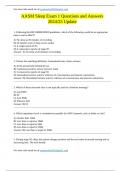Exam (elaborations)
AASM Sleep Exam 1 Questions and Answers 2024/25 Update
- Course
- AASM Sleep (AASMSLEEPEXAM)
- Institution
- American Academy Of Mcallister Institute
AASM Sleep Exam 1 Questions and Answers 2024/25 Update Test 1 / 400 AASM Sleep Tech Practice Questions Print test Options ...
[Show more]




